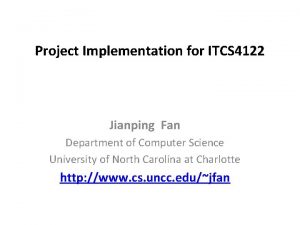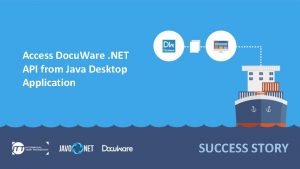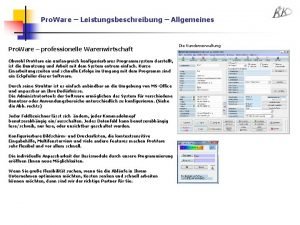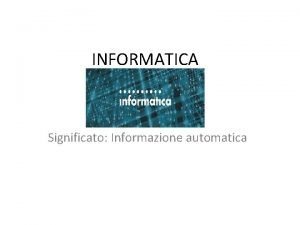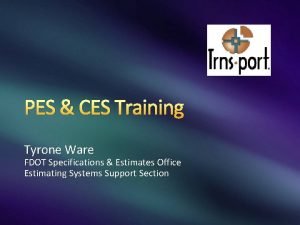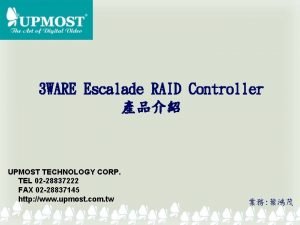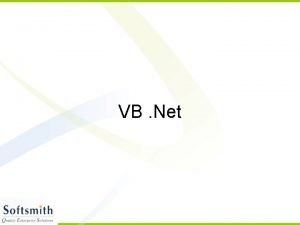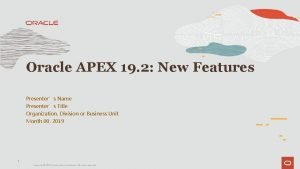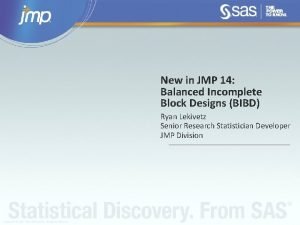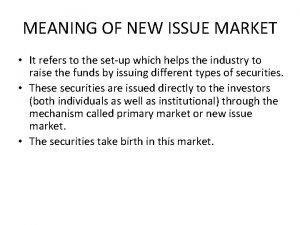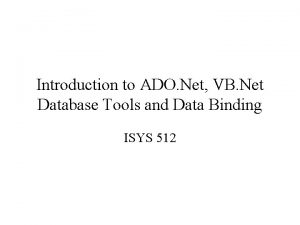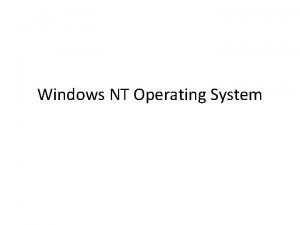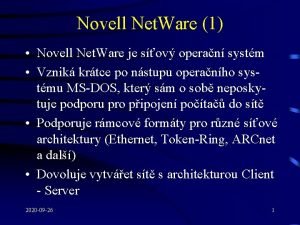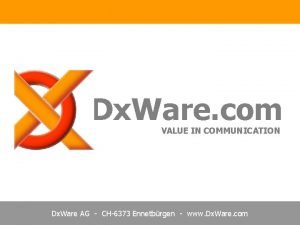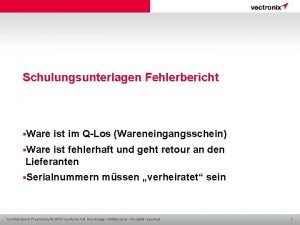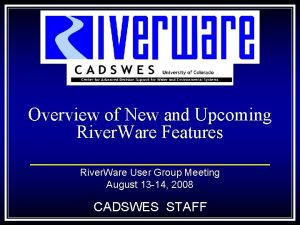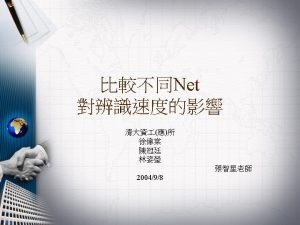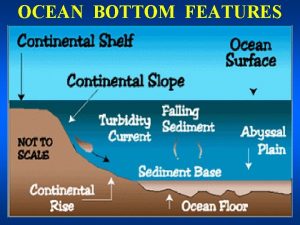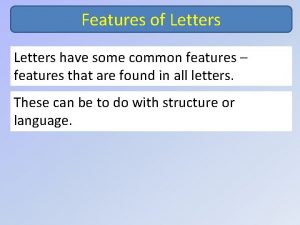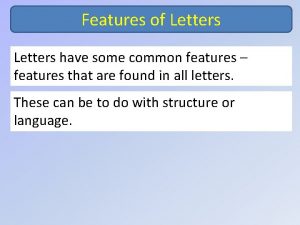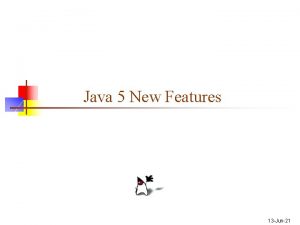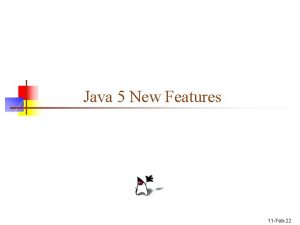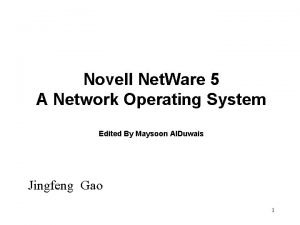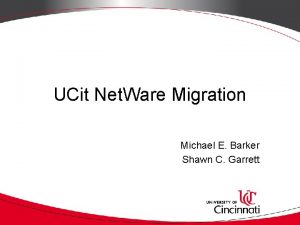New Features of Net Ware 4 x Jianping











































- Slides: 43

New Features of Net. Ware 4. x Jianping zeng Kelong wu

Index Contents • What is Net. Ware; • Motivation for new Net. Ware 4. x features; • Net. Ware Directory Service(NDS): • Logical Organization of the network; • Single Login to the network; • Global Network Management; • Independence from Physical Location of Resources; • Improvements in the Net. Ware File System; • Improved File System Security;

Index Contents • Support for Network Auditing; • Simplified and more efficient Memory Management Architecture; • Improvements in Client Networking Services; • Integrated Storage Management Services(SMS); • Improvements in Network Print Service Architecture; • Multiple Language Support; • Simplified Installation and Upgrade Procedures; • Conclusion.

Index What is Net. Ware • Is an operating system for hosting file volumes across a network --- a network operating system(NOS); • Was not designed as an application-development platform, nor as a desktop operating system; • Is one of the most well-established and strongestselling NOS product; • Has more than half the file/print-sharing server market, and might continue to hang on to that edge into the next century.

Motivation for Net. Ware 4. x Index • A network can consist of several LANs tied together with wide area links as shown in figure 1 Figure 1: Net. Ware-based network

Index Motivation for Net. Ware 4. x • In the earlier versions of Net. Ware • The user would have to know the names of the file servers to which the printer and volume resources are attached before he access them; • The user would have to log in to that server at first if he wanted to use its resources; • The user would have to attach to that server and then create a separate drive mapping; • Access to resources was controlled by a security mechanism that was local to each other(called the bindery).

• In the Net. Ware 4. x Index • It has the logical view of the network, resources are organized into groups that are in turn organized into a hierarchy that reflects their usage, function, or geographical location, and forget about the physical links(such as routers or bridges) shown as in figure 2; • The user can login to this logical view of the network; • Access to resources on the network can be controlled by security mechanisms that are global in scope and apply to entire network; • To provide a single access to the network, Net. Ware 4. x created a global database called the Net. Ware Directory Service (NDS). NDS provide a global database service that is not confined to a single server and represents network-wide resources.

• In the Net. Ware 4. x Figure 2: logical view of the network Index

Index Net. Ware Directory Service (NDS) • Function of NDS: · It provides the network administrator and a logical view of a network; · The logical view of the network can be easily recognized by the user; · It provides a distributed database that can act as a repository of information on all the shared resources on the network; · Is replacement for the bindery services of the early version. The bindery could not easily support information on other nodes on the network.

Index Net. Ware Directory Service (NDS) • Benefits of NDS: · Logical organization of the network; · Single login to the network; · Global network management view; · Independence from physical location of resources.

Index Logical Organization of the network · The resources can be grouped in a hierarchical in the NDS representation; · Make it easy for the users and network administrators to find the network resources without knowing the physical details of network connectivity; · The user who needs to use a network resource has a logical pointer (called object which contain information on the resource) to the NDS database; ·In figure 3, a file server can be modeled as a file server object which contains the information such as the name of the file server, its network address, location, and so on. Figure 3: file server object

Index Single Login to the network • Enables a user to be authenticated just once to access all the resources on the network even though he cannot access all the objects in this directory (figure 4); • Administrator gives him the access priority; Figure 4: single login

Single Login to the network Index · After a user logs in, the network administrator can limit access to resources on the network. When the user authentication is successful, the user is granted access to any resource on the network( figure 5); Figure 5: user authentication to the network

Index Single Login to the network · In earlier version, the user had to login every server to which he wanted access and the number of such concurrent connection was limited to 8; · In Net. Ware 4. x, the maximum number of concurrent connections to different Net. Ware servers is increased from 8 to 50.

Index Global Network Management • In the early version, the network management tasks had to be performed separately on each Net. Ware server, because network management usually resulted in a modification of the bindery, and the bindery was specific to each server; ·In Net. Ware 4. x, the network administrator can change network resources from any place on the network. (figure 6); Figure 6: global network management

Independence from Physical Location of Resources Index • In the early version, the resources were described in a server bindery and depended on that server (figure 7); • In Net. Ware 4. x, resources are not tied to a specific server or a physical location on the network. The NDS object can be accessed from any station on the network Figure 7: Bindery representations of printer definitions when the user gets the permission.

Index Improvements in the Net. Ware File System • Block Suballocation · Disk suballocation can be enable/disable at the installation time; · The disk block size was selected at the installation time to be 4 KB, 8 KB, 12 KB, 16 KB or 64 KB; · Net. Ware 4. x allows small files and files that are not multiples of the disk block size to share space in a disk block that would otherwise have gone wasted (figure 8).

Index Improvements in the Net. Ware File System Figure 8: Disk suballocation

Index Improvements in the Net. Ware File System • Net. Ware File System Compression · Compress option can be enable/disable at the installation time (default is enable); · The disk block will be compressed as it is written and decompressed by special decompress threads as it is read (figure 9); · This compress option can increase the effective disk space without adding new server drives.

Index Improvements in the Net. Ware File System Figure 9: Read of a compressed file

Index Improvements in the Net. Ware File System • Data Migration · Allows infrequently used files to be moved to a nearline storage medium (such as optical disk libraries) or off-line storage medium (such as tape backup devices); · When data migration occurs, Net. Ware 4. x still sees the data on the Net. Ware volumes; · If a file is accessed and it has been migrated, the file is brought back into the Net. Ware volume(figure 10); · It is a very effective way to save on disk space when combined with compression; · When files are the least active or have not been accessed for the longest period of time (eg. Exceeds a capacity threshold), data migration occurs.

Index Improvements in the Net. Ware File System Figure 10: Data migration

Improved File System Security Index · Access to parts of the network directory tree are controlled by explicit trustee assignments; · When a user logs in, he specifies the name of the NDS object that represents the user account. The user’s login name and password are used to build a personalized key that is used to authenticate a user’s right to access the network (figure 11);

Improved File System Security Index Figure 11: Net. Ware 4. x security · The user must pass the NDS security level. He must have certain rights to the volume object in the directory tree; · Then the user’s access to a file is controlled by the File and Directory Trustee rights.

Support for Network Auditing Index · In Net. Ware 4. x, a class of users called auditors can be set up to act independently of the network administrator in order to audit critical activities on the network; · The auditors can also audit past and present transactions on the network for any security breaches(figure 12); · Auditing allows the monitoring of critical events on the network, such as logins and logouts, file operations, directory services object operations(creations, deletions, reads and writes), directory object events, user events and trustee modifications.

Index Support for Network Auditing Figure 12: Auditing in Net. Ware 4. x

Index Simplified and More Efficient Memory Management Architecture • In Net. Ware 3. x: · Memory management in Net. Ware 3. x is shown as figure 13; memory was managed in five pools, each serving a different purpose; Figure 13: Net. Ware 3. x memory management

Index Simplified and More Efficient Memory Management Architecture • In Net. Ware 3. x: · The pools were for purposes such as cache movable, cache nonmovable, permanent memory and semipermanent memory; · Memory pools were permitted to borrow memory from the file cache buffer memory, but once borrowed, this memory was not returned; · To reset the memory pools, the server had to be restart.

Index Simplified and More Efficient Memory Management Architecture • In Net. Ware 4. x: · There is only one main pool – the file cache memory (figure 14); · All memory used by processes running on the server are borrowed against this pool and completely returned to it when the process terminates; · Other processes can reuse the returned memory. Figure 14: Net. Ware 4. x memory management

Index Some of the features of Net. Ware 4. x memory management · Improved server performance, because memory management is an important resource for server processes; · Integration with the paged memory architecture of the Intel processors; · Ring protection to control damage caused by misbehaved NLMs (Net. Ware loadable module); · Easier-to-write applications for the NLM developer because memory management is simpler.

Index The Ring architecture of Net. Ware 4. x · The operating system kernel is running in Ring 0. All NLMs run in Ring 0 by default but the network administrator can configure server to run NLM that are loaded in an outer ring (figure 15); · A program at Ring 3 would have to make an inter-ring gate call to make service requests from the operating system kernel; · If program crash, it cannot affect the kernel; · More reliable but reduce speed.

Index The Ring architecture of Net. Ware 4. x Figure 15: Interl 80386 processor ring architecture

Index Improvements in Client Networking Services • Net. Ware 4. x includes better support for DOS, MS Windows, and OS/2 (figure 16). DOS and MS Windows use a DOS requester, ODI support and Packet Burst Protocol support; Figure 16: Multiple client support Net. Ware 4. x

Index Improvements in Client Networking Services · DOS requester allows the redirector capability of later releases of DOS via the interrupt mechanism INT 2 F (hex) to be used. · DOS requester consists of number of smaller components (called Virtual Loadable Modules and managed by VLM manager VLM. EXE) that need to be loaded only if the service is needed. · ODI support is the Open Data-Link interface that provides an interface for protocol stacks to talk to network boards, which represent layer 2(data-link layer) of the OSI model.

Index Improvements in Client Networking Services · Packet Burst Protocol allows transmission of multiple packet requests and packet replies. A number of requests or replies can be acknowledged by a single acknowledgement packet. · Net. Ware 4. x supports for Large Internet Packet(LIP) which means larger packet size that are common in Token Ring networks(4 KB to 16 KB) and Ethernet networks (1. 5 KB) are possible.

Integrated Storage Management Services (SMS) Index · SMS provide for data on the network to be backed up or restored in a common data format and in a manner that is hardware- and softwareindependent; · The device that needs to be backed up is called the target. The target could be a workstation, a Net. Ware 3. x server, or a Net. Ware 4. x server; · A Target Service Agent(TSA) program is run on the target and communicates with the SBACKUP program. (figure 17);

Index Integrated Storage Management Services (SMS) Figure 17: SMS and TSAs

Index Integrated Storage Management Services (SMS) · In SMS, the SBACKUP program is responsible for backup and restore operations. SBACKUP is an NLM that runs on a Net. Ware server. · Other modules in SMS are Storage Management Data Register(SMDR—used to pass commands between SBACKUP and the TSAs), Storage Device Interface(SDI—communicate between the SBACKUP program and the storage devices). (figure 18)

Index Integrated Storage Management Services (SMS) Figure 18: SMS architecture

Improvements in Network Print Service Architecture Index · Print jobs can be sent to the network print queue or be sent to the printer object in the NDS tree; · Simpler installation in comparison to Net. Ware 3. x; · Support for a larger number of printers (up to 256) on a single print server; · Support for remote printers on Net. Ware servers.

Multiple Language Support (Internationalization) Index · Net. Ware 4. x has introduced support for international languages to Net. Ware Loadable Modules and network utilities. · Having different language NLMs running on the server at the same time or having one user using the system utility in French and another using the same utility in Italian are even possible. · Does not mean Net. Ware is capable of translating messages between users using different languages.

Index Simplified Installation and Upgrade Procedures · Net. Ware 4. x distribution comes in CD-ROM. ; · The CD-ROM drive can be attached to the server being installed, or to a remote workstation(figure 19); · In the figure 19, the CD-ROM is shown as an external unit to the workstation or server. Internal CD-ROMs also are possible. Figure 19: Net. Ware 4 installation using CD-ROM distribution

Index Conclusion · In some ways, Net. Ware 4. x is very similar to Net. Ware 3. x, but in other ways, Net. Ware 4. x represents a radical departure. · You can learn more about Net. Ware 4. x from the book “Migrating to Net. Ware 4. 1”
 Jianping fan
Jianping fan Warenet
Warenet Pro ware
Pro ware Odessy ware
Odessy ware Ware significato informatico
Ware significato informatico Gcu chancellor scholarship
Gcu chancellor scholarship Vodka chimney glass
Vodka chimney glass Unix ware
Unix ware Preisangabenverordnung preisschild
Preisangabenverordnung preisschild Kevin ware injury
Kevin ware injury Roger ware
Roger ware Rena ware material
Rena ware material Ware fc
Ware fc Control group
Control group 오렌지 프로시저 디버깅
오렌지 프로시저 디버깅 3 ware
3 ware Features of vb net
Features of vb net Oracle apex 19
Oracle apex 19 Jmp 14 new features
Jmp 14 new features New criticism theory
New criticism theory Function of new issue market
Function of new issue market Features of new criticism
Features of new criticism Marklogic 8 new features
Marklogic 8 new features Achmed lach net ich krieg mein tach net
Achmed lach net ich krieg mein tach net Ado.net vb.net
Ado.net vb.net Twinspace sohbet odası
Twinspace sohbet odası New equipment training
New equipment training Twinspace etwinning net
Twinspace etwinning net Split speech punctuation
Split speech punctuation New york pennsylvania new jersey delaware
New york pennsylvania new jersey delaware New oil and new wineskin
New oil and new wineskin Marquee cinemas orchard 14
Marquee cinemas orchard 14 Articles of confederation strengths and weaknesses
Articles of confederation strengths and weaknesses New-old approach to creating new ventures
New-old approach to creating new ventures Kotler and keller
Kotler and keller Njbta
Njbta New classical and new keynesian macroeconomics
New classical and new keynesian macroeconomics Chapter 16 toward a new heaven and a new earth
Chapter 16 toward a new heaven and a new earth Neil thisse is a loyalist who fled the colonies
Neil thisse is a loyalist who fled the colonies New classical and new keynesian macroeconomics
New classical and new keynesian macroeconomics Comparing progressive presidents roosevelt taft and wilson
Comparing progressive presidents roosevelt taft and wilson Young and dyslexic text
Young and dyslexic text Features of windows nt operating system
Features of windows nt operating system Vancomycin psc
Vancomycin psc
